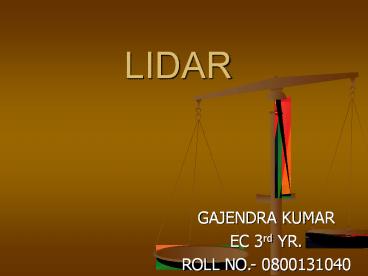LIDAR PowerPoint PPT Presentation
Title: LIDAR
1
LIDAR
- GAJENDRA KUMAR
- EC 3rd YR.
- ROLL NO.- 0800131040
2
CONTENTS
MADE BY MANISH KR.
- Introduction
- LIDAR- What???
- Why???
- How(operating principle)???
- Traditional photography VS Lidar
- Components and
- Characteristics
3
LIDAR
- Light Detection And Ranging
- is an optical remote sensing technology that can
measure the distance to, or other properties of a
target by illuminating the target with light,
often using pulses from a laser.
4
General Description
- LIDAR uses ultraviolet, visible, or near infrared
light to image objects and can be used with a
wide range of targets, including non-metallic
objects, rocks, rain, chemical compounds,
aerosols, clouds and even single molecules.1 A
narrow laser beam can be used to map physical
features with very high resolution.
5
HOW????
- Each time the laser is pulsed
- Laser generates an optical pulse
- Pulse is reflected off an object and returns
- to the system receiver
- High-speed counter measures the time of flight
from the start pulse to the return pulse - Time measurement is converted to a distance (the
distance to the target and the - position of the airplane is then used to
determine - the elevation and location)
- Multiple returns can be measured for each pulse
6
COMPONENTS
- LASER
- SCANNER AND OPTICS
- PHOTODETECTOR AND RECEIVER
- POSITION AND NAVIGATIONAL SYS.
7
LASER
- -6001000 nm lasers are most common for non
scientific applications - -Airborne topographic mapping lidars generally
use 1064 nm diode pumped YAG lasers - -Better target resolution is achieved with
shorter pulses, provided the LIDAR receiver
detectors and electronics have sufficient
bandwidth1.
8
SCANNER AND OPTICS
- How fast images can be developed is also affected
by the speed at which it can be scanned into the
system . - There are several options to scan the azimuth and
elevation, including dual oscillating plane
mirrors, a combination with a polygon mirror, a
dual axis scanner
9
PHOTODETECER
- Two main photodetector technologies are used in
lidars solid state photodetectors, such as
silicon avalanche photodiodes, or
photomultipliers - The sensitivity of the receiver is another
parameter that has to be balanced in a LIDAR
design.
10
NAVIGATIONAL SYS.
- LIDAR sensors that are mounted on mobile
platforms such as airplanes or satellites require
instrumentation to determine the absolute
position and orientation of the sensor. - Such devices generally include a Global
Positioning System receiver and an Inertial
Measurement Unit (IMU).
11
BASIC PRINCIPLE
- Similar principle to RADAR pulses of light
emitted into the atmosphere and scattered back by
clouds, aerosols or air molecules - Light collected by a telescope
- Spectrometers or interference filters isolate
wavelength concerned - Photon-counting or analogue detection
- Time-of-flight gives scattering height z2ct
12
TRADITIONAL PHOTOGRAPHYVSLIDAR
- 1.Day time collection only
- 2. Complicated and sometimes unreliable
procedures - 3. Planimetric accuracy is better than vertical
- 1.Day or night data acquisition
- 2.Direct acquisition of 3D collection
- 3. Vertical accuracy is better than planimetric
13
APPLICATIONS
- AGRICULTURE
- ARCHAEOLOGY
- BIOLOGY CONSERVATION
- GEOLOGY
- HYDROLOGY
- METROLOGY
14
(No Transcript)

